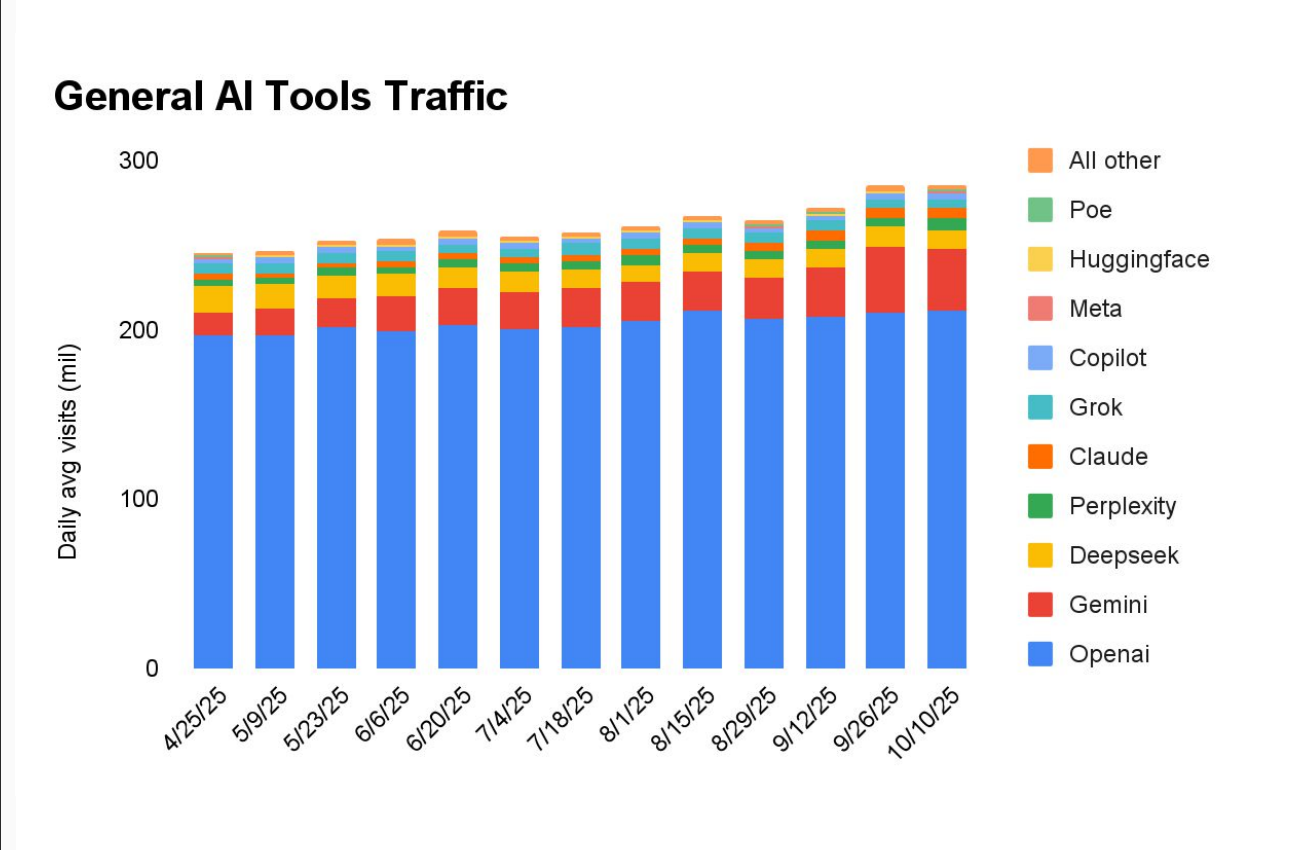Recent web traffic data shows a clear adjustment in the generative AI market. OpenAI remains the leader, but its share is shrinking as established technology companies expand their reach. Similarweb[1]’s October 2025 Global AI Tracker[2] indicates that traffic growth is spreading across multiple providers as the market matures.
Over the past year, ChatGPT’s global traffic share has dropped from 87.1 percent to 74.1 percent. The decline reflects a broadening field rather than a collapse in usage. As overall interest in AI tools grows, new users are entering through platforms backed by companies with strong distribution networks. Google’s Gemini has moved from 6.4 percent to 12.9 percent, a gain linked to its visibility inside Google’s existing services. Integration across Search, Workspace, and Android gives Gemini consistent exposure to daily users and drives habitual adoption.
Chamath Palihapitiya[3] described this trend as proof that “distribution matters.” Data in the Similarweb report supports that view. Gemini recorded 64 percent growth in the most recent twelve-week period, while Meta’s AI traffic rose 102 percent after earlier declines. Both companies benefit from large, built-in audiences that can be converted into AI users without major marketing costs. Technical capability remains important, but scale, network and access are becoming stronger factors in market position.
Perplexity continues to rise, passing 2.4 percent share and showing 66 percent growth over the past quarter. Its focus on fast, reference-style responses seems to match what many users want: quick retrieval over chat-style interaction. Claude and Grok each hold around 2 percent of traffic. Their slower growth suggests that awareness and accessibility play a larger role than model design.
Category data from Similarweb shows uneven momentum across the wider ecosystem. The General AI Tools category, which includes ChatGPT and Gemini, grew 11 percent year over year. Creative and niche tools showed weaker performance. Design and image generation fell 9 percent, voice generation dropped 12 percent, and automation platforms lost modest ground after midyear peaks. The shift indicates that users are consolidating around multi-purpose AI systems rather than specialized applications.
Developer-focused AI tools show the sharpest slowdown. The DevOps and code completion category declined 15 percent in recent data. Many developers appear to have tested these platforms but didn’t keep using them once projects required complex integration. Interest in AI-assisted coding remains, but engagement levels show that most tools still fall short for production-level work.
Outside the core model market, movement varies by sector. Design platforms like Canva and Figma continue to perform well. Canva’s traffic is up 26 percent year over year, while Figma holds steady near 8 percent growth. Both benefit from gradual adoption of embedded AI features. In contrast, digital freelance, search, and education technology sectors show flat or declining activity. These areas are influenced by longer product cycles and user habits that evolve more slowly.
The broader message from Similarweb’s October dataset is that the AI market has entered a redistribution phase. OpenAI still sets the benchmark for general-purpose models, but other firms are capturing attention through existing ecosystems. Google’s integration strategy is producing steady results, while Meta’s rebound points to renewed engagement across its platforms. Emerging players like Perplexity are building smaller but consistent bases of returning users.
The next stage of competition will likely center on reach and reliability rather than novelty. For OpenAI, maintaining leadership will depend on expanding distribution while keeping product quality stable. For incumbents, continued growth depends on improving model performance within familiar services. The new data reflects a market that is expanding but also normalizing, where distribution and user access are starting to define long-term advantage.
Notes: This post was edited/created using GenAI tools.
Read next: The Internet’s “Most Human Place” Faces Its Most Inhuman Challenge Yet[4]
References
- ^ Similarweb (x.com)
- ^ October 2025 Global AI Tracker (www.similarweb.com)
- ^ Chamath Palihapitiya (x.com)
- ^ The Internet’s “Most Human Place” Faces Its Most Inhuman Challenge Yet (www.digitalinformationworld.com)


